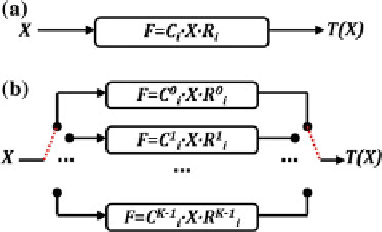Game Development Reference
In-Depth Information
in Fig.
5.3
, for intrapredictions including DC mode and different prediction direc-
tions, which are illustrated by the blue arrows, the absolute magnitude of the pre-
diction residues shows different distribution patterns. Basically, for sample positions
closer to the reference samples, the prediction residue presents lower magnitude, and
the residue magnitude becomes larger along the prediction direction. As the differ-
ent intraprediction modes present different statistics, in (Ye and Karczewicz,
2008
)
an
MDDT
method is proposed using a pair of KLT-based horizontal and vertical
transforms for each intraprediction direction. The KLT-based transform matrices are
derived by offline training using a cluster of intraprediction residue blocks.
Although it was shown in (Ye and Karczewicz,
2008
) that
MDDT
efficiently
improves the intraprediction coding efficiency as compared to
DCT
,
MDDT
involves
high computation complexity since there are totally 9 pairs of horizontal and vertical
KLT transformmatrices and relatively large number of multiplications are needed. To
further reduce the complexity of
MDDT
, instead of 9 pairs of irregular
KLT
transform
matrices, it is analytically proved in (Saxena and Fernandes,
2011
) that utilization
of only
DCT
and
DST
transform matrices can efficiently approximates
MDDT
.
Furthermore, it was pointed in (Zhao et al.,
2012
) that intraprediction residual
present dynamic statistics, and the residual distribution can varies significantly even
for the same intraprediction direction. Based on this investigation, it is proposed in
(Zhao et al.,
2012
) to apply multiple candidate transforms, as shown in Fig.
5.4
and
the most efficient one in terms of rate-distortion cost is explicitly signaled in the
bit-stream. It was shown that this multi-candidate transform approach, namely rate-
distortion optimized transform (
RDOT
), doubles the coding gain of
MDDT
compared
to the conventional
DCT
.
Although higher complexity is needed for these new transform approaches, it is
proved that there is room to further improve the transform efficiency on top of the
conventional
DCT
, which has been widely used in video coding for several decades.
Fig. 5.4
Comparison on the
transform schemes of
MDDT and RDOT (Zhao et
al.
2012
).
a
MDDT.
b
Proposed RDOT

